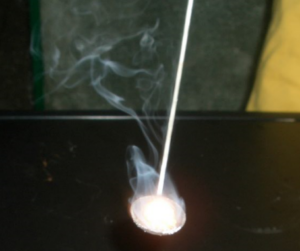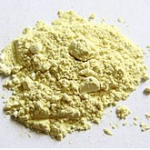Basic oxides are oxides that are basic in nature and it contains one or more oxygen atoms either they react with water to give a base or they react with an acid to form a salt. In the periodic table, Group 1 is alkali, Group 2 elements are alkaline earth metals, group 13 element is Tl2O, and group 15 element that is Bi2O3 form basic oxides. Basic oxide examples include
- Lithium Oxide (Li2O)
- Sodium Oxide (Na2O)
- Potassium Oxide (K2O)
- Rubidium oxide (Rb2O)
- Cesium oxide (Cs2O)
- Magnesium oxide (MgO)
- Calcium oxide (CaO)
- Strontium oxide (SrO)
- Barium Oxide (BaO)
- Thallium (I) oxide (Tl2O)
- Bismuth (IΙΙ) oxide (Bi2O3)
1. Lithium Oxide:
The chemical formula of Lithium oxide is Li2O. It is a white solid formed when lithium metal is burned in the air and combines with oxygen at temperatures above 100 °C
4Li + O2 → 2Li2O.

Lithium oxide reacts with water and steam and forms lithium hydroxide. It is used in the ceramics industry and barrier coating.
2. Sodium Oxide:
The chemical formula of Sodium oxide is Na2O. It is a white solid which is formed by the reaction of sodium with sodium hydroxide the reaction is as follows:
2NaOH + 2Na → 2Na2O + H2
The reaction of Sodium oxide with water gives Sodium hydroxide which is a base. The reaction is given below
Na2O + H2O → 2 NaOH
Sodium Oxide undergoes a neutralization reaction to produce acid called hydrochloric acid and salt called sodium Chloride. The reaction is given as
Na2O + 2HCl → 2NaCl + H2O
In various materials such as ceramics and glasses, sodium oxide is used as a component.
3. Potassium Oxide:
Chemical formula of potassium oxide is K2O. It is a pale yellow solid which is highly reactive in nature. Potassium oxide is produced by the reaction of peroxide with potassium.
K2O2+2K→ 2K2O
4. Rubidium oxide:
Chemical formula Rubidium oxide is Rb2O. It is a yellow colored solid which play an important role in the application of fuel cells. It reacts with water to form rubidium hydroxide which is given as
Rb2O + H2O → 2 RbOH
Rubidium oxide reacts with hydrogen which produces rubidium hydride and rubidium hydroxide. The reaction is as follows
Rb2O + H2 → RbOH + RbH
5. Cesium oxide:
Chemical formula Cesium oxide is Cs2O. It is a yellow-orange color crystal which is used in TV camera photocathodes. Cesium oxide reacts with water to produce Cesium hydroxide.
Cs2O (s) + H2O (l) → 2CsOH (aq)
6. Magnesium oxide:
Chemical formula of Magnesium oxide is MgO. It is a white hygroscopic solid consists of Mg2+ and O2- ions held together by ionic bonding. Magnesium oxide reacts with water to form Magnesium hydroxide
MgO + H2O → Mg (OH)2
Magnesium oxide undergoes neutralization reaction to produce acid called hydrochloric acid and salt called Magnesium Chloride. The reaction is given as
MgO + 2 HCl → MgCl2 + H2O
Some of the physical property of Magnesium Oxide is it is a good thermal conductor and electrical insulator which is extensively used in thermal insulation and firebrick. Magnesium Oxide is used in medical applications, food additives, as insulators, plant fertilizers, and animal feedings.
7. Calcium oxide:
The chemical formula of Calcium oxide is CaO. It is also called quicklime or lime. Calcium oxide reacts with water and produces a base called calcium hydroxide.
CaO +H2O → Ca (OH)2
Some of the uses of Calcium oxide is used extensively in the steel industry, in water purification.
8. Strontium oxide:
Chemical formula Strontium oxide is SrO. It is white in color and is soluble in potassium hydroxide. Mixture of Strontium Oxide and strontium nitride is formed by burning of strontium in air. Strontium oxide play an important role in cathode ray tubes and to block the X-ray emission.
9. Barium Oxide:
Chemical formula Barium oxide is BaO. It is a non-flammable compound which is in white in color. It is prepared by heating barium carbonate at high temperature.
BaCO3 → BaO + CO2
Barium oxide is used as a component in crown glass, cathode ray tubes and catalysts.
10. Thallium (I) oxide:
Chemical formula Thallium (I) oxide is Tl2O where thallium is in +1 oxidation state. It is a group 13 element which is in black in color and changes to yellow color when dissolved in water which produces thallium (I) hydroxide.
Thallium (I) oxide reacts with water to produce Thallium (I) hydroxide. The reaction is given below
Tl2O (s) + H2O (l) → 2 TlOH (aq)
It is used as important component in high temperature superconductors and in high index glass.
11. Bismuth (IΙΙ) oxide:
Chemical formula Bismuth (IΙΙ) oxide is Bi2O3. Bismuth is belongs to group 15 element in the periodic table and it is yellow in color.

Bismuth (IΙΙ) oxide reacts with water to produce Bismuth (III) hydroxide.
Bi2O3(s) + 3 H2O (l) → 2 Bi(OH)3 (aq)
Bi2O3 is used in solid-oxide fuel cells, dental materials and hydraulic silicate cements.
Conclusion:
Basic oxides are basic in nature either it react with water or acid. Alkali, alkaline earth metal, group 13 element that is Tl2O and group 15 element that is Bi2O3 are the examples for basic oxides and also they are basic in nature.

Hi….I am Supriya Upadhya, a Post Graduate in Organic chemistry with good understanding of Chemistry concepts and worked as Junior research fellow in synthesis of anti cancer agent. Also worked on Anti-Microbial Polymer synthesis as part of Post graduate thesis.